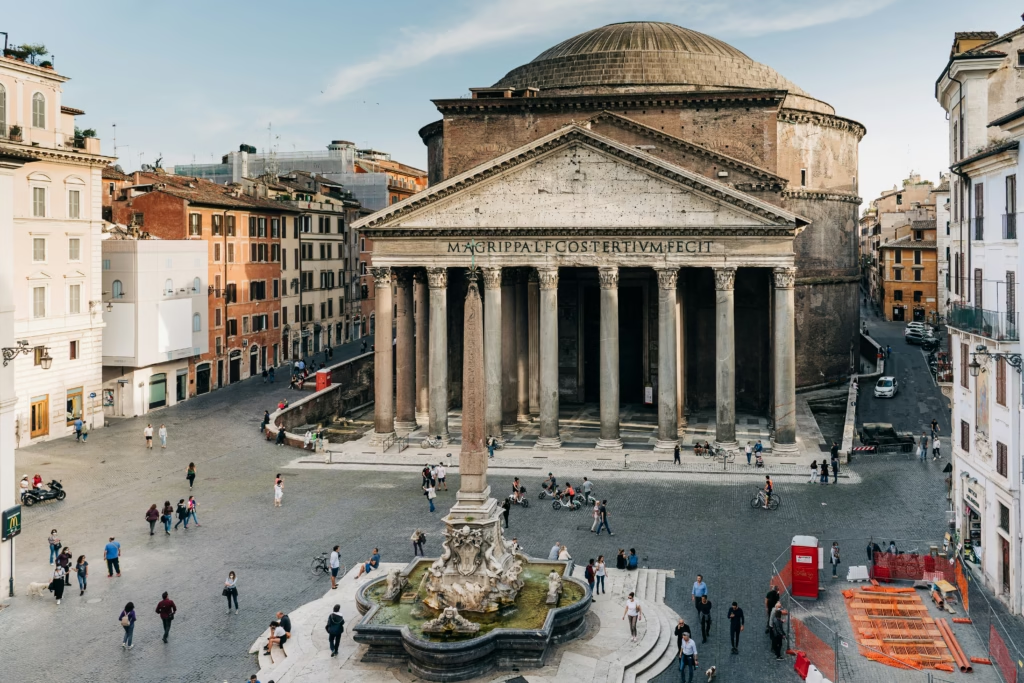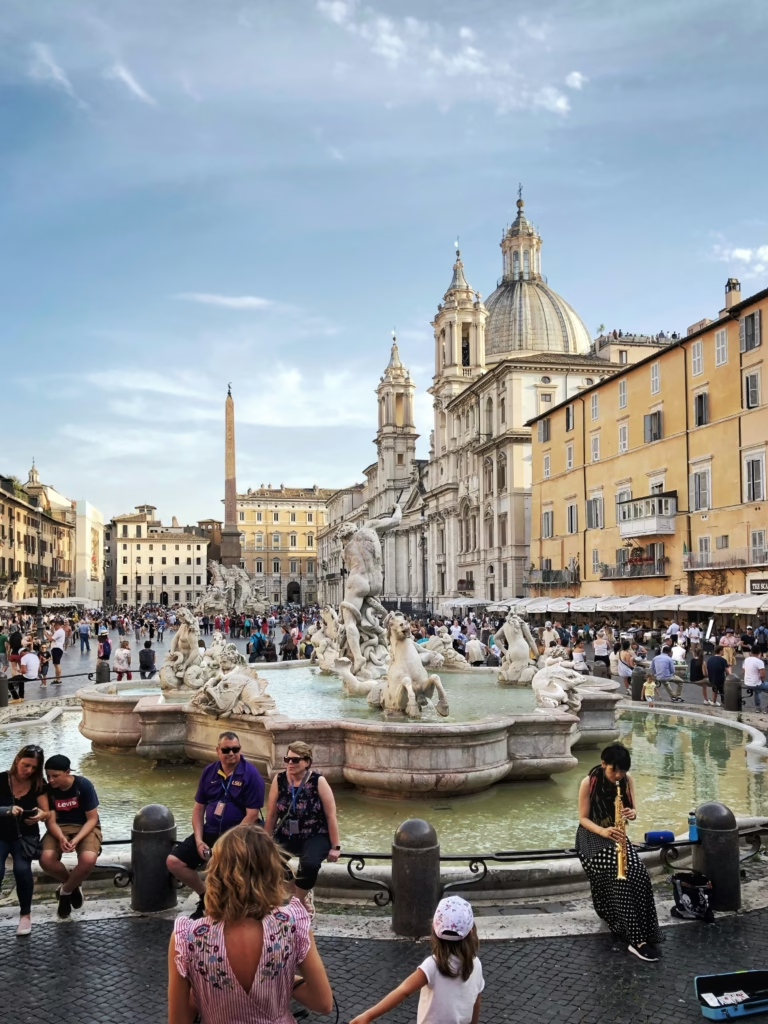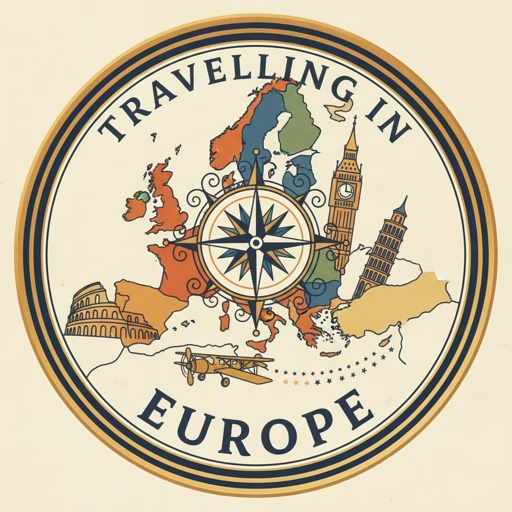Rome in Four Pages — a slightly witty, deeply romantic tourist guide

Rome in Four Pages — a slightly witty, deeply romantic tourist guide
(Pack comfy shoes, an appetite for pasta, and at least one cardigan — Romans like to look put together.)
Page 1 — Arrival: by plane or train (and which airport is which)
Fly in: the three airports (yes, three — sort of)
Rome’s air travel scene centers on two main airports and a tiny third for private flights. Know which one you’re booked into — it’ll save you hangry confusion.
- Fiumicino — Leonardo da Vinci (FCO)
The big international hub: long-haul flights, plenty of amenities, and the fastest public links to the center (Leonardo Express train). If your flight is from outside Europe (or through a major airline), it will most likely land here. - Ciampino (CIA)
Smaller, closer to the city, and the favourite haunt of many low-cost carriers. If your ticket says “Ciampino,” expect simpler terminals and shuttle buses into the center. Ryanair and Wizz Air commonly use Ciampino as a base (and sometimes Fiumicino too). - Roma-Urbe (LIRU) — the “third” airport
Tiny, near the north of the city, mainly for private/general aviation and occasional charter flights. Not the place for scheduled commercial arrivals — but worth knowing if you see it on a booking.
How to get from the airports to the city: quick start
- From Fiumicino (FCO) — take the Leonardo Express non-stop train to Roma Termini (≈32–40 minutes; ticket around €14). It’s fast and worry-free. Alternatively, regional FL1 trains and airport buses run to different stations. Trenitalia
- From Ciampino (CIA) — no direct train. Use shuttle buses (Terravision, SITbus, Terrapark etc.) to Termini (≈30–45 minutes), or a taxi (fixed fare to center often applies). Book shuttle tickets online or buy at kiosks. Terravision
- From Roma-Urbe (LIRU) — local buses or a short taxi ride; it’s a small general-aviation strip inside the city ring.
Budget airlines that frequently fly to Rome
Ryanair, easyJet, Wizz Air, Vueling (and others) serve Rome — often using Ciampino and Fiumicino depending on route and season. If you’re price-hunting, compare fares and check which airport your low-cost flight uses (it matters for time & transfer cost). Skyscanner
Pro Tip
If you land at Ciampino, assume a bus + metro/train combo into the center unless you’ve pre-booked a taxi. If you land at Fiumicino, buy a Leonardo Express ticket at the station for a calm, non-stop ride to Termini.
Page 2 — Arriving by train; main rail stations & intercity hops
Rome is a major rail hub — glorious news for lovers of scenic travel.
Main stations
- Roma Termini — the big one. Central, busy, full of cafés, and the main interchange for metro lines A and B. If rail brings you to Rome, chances are you’ll disembark here.
- Roma Tiburtina — modern and efficient, often used by high-speed services and some trains that bypass Termini. Useful if your itinerary includes Naples or Bologna. ItaliaRail
High-speed connections (perfect for multi-city trips)
- Florence ≈ 1h 20–90m (Italo or Trenitalia Frecciarossa) — ideal for a day trip or continue your Italian odyssey.
- Naples ≈ 1–1.5h — pizza + ruins (Pompeii) accessible.
- Milan ≈ 3h — fashion capital, different rhythm.
- Venice ≈ 3.5–4h — lagoon romance.
Book Italo or Trenitalia in advance for the best fares. Trains are comfortable, fast, and scenic in their quieter stretches.
Pro Tip
Buy high-speed train tickets online (Trenitalia / Italo) weeks ahead for discounted fares (not that expensive last minute either). If your hotel is near Termini, you can drop your bag and start exploring right away — despite the smell of late-night pizza in the station, Termini is a time-saving hub.
Page 3 — Getting around Rome: metro, buses, trams & the unglamorous truth
Rome’s public transport is extensive but famously imperfect. Think charming chaos with the occasional broken escalator.
Metro basics
- Lines: A (orange), B/B1 (blue), and C (green, partial). The metro is useful for fast east–west or north–south hops, but it doesn’t reach many historic centre streets — in fact, much of Centro Storico is a walking zone.
- How to use it: Buy tickets at machines (coins/cards accepted) or tobacconists (tabacchi). A standard BIT ticket (single) covers 100 minutes of travel including one metro ride and several bus trips, but does not include Leonardo Express or airport transfers. There are also day passes (48h / 72h) and the Roma Pass which bundles some museum discounts and public transport — check current prices on ATAC’s site. Atac
Buses & trams
- Buses fill the gaps the metro doesn’t — very useful but sometimes slow (and occasional delays or strikes happen). Validate your ticket on the first bus; inspectors do fines, and pickpockets admire overcrowded buses.
Taxis & rideshares
- Official white taxis are metered; rideshares operate in the city. Agree on airport/taxi fixed fares if offered (or use official ranks).
Pro Tip
Carry small change or a contactless card for ticket machines. Validate every single ticket — fines are real and merciless. If the metro is your lifeline, aim for lines A or B; line C is still being expanded and can be less useful for tourists.
Say goodbye to roaming shock and hello to seamless mobile data with Yesim eSIM—your passport to affordable internet in 200+ destinations. Get 20% off your first eSIM Use promo code FALLY20 at checkout. No hidden fees. No physical SIM. No contracts. Just pure travel freedom.
(affiliate link)


Page 4 — Sights, tickets, food, etiquette & a small, solemn detour
The must-see list (and ticket advice)
Rome’s “musts” are famous for a reason. Book ahead where you can; lines bite into joyful time.
- Colosseum + Roman Forum + Palatine Hill — combination tickets and timed entries are standard. Avoid unofficial resellers; Italy’s regulator has recently cracked down on bad ticketing practices and inflated resale bundles — use official booking channels or reputable vendors. Book a morning time slot for cooler, less crowded visits.
- Vatican Museums & Sistine Chapel — buy tickets on the official Vatican Museums site for skip-the-line options and to avoid scams; early morning or late afternoon slots help escape the crush. Guided tours are worth it if you want context for the ceiling drama. Vatican Museums
- St. Peter’s Basilica — free to enter, but lines for security can be long. Dome climb costs extra (cash/card at desk) — the views repay the stairs.
- Pantheon — ancient miracle with an open oculus; modest entrance fee may apply for the upper floors/visits.
- Trevi Fountain — coin toss required by tradition (one coin: you’ll return; two: you’ll find love; three: you’ll marry someone with a huge appetite — kidding). Best seen early morning or late night to avoid photo mobs.
- Piazza Navona, Spanish Steps, Trastevere, Villa Borghese, Borghese Gallery — the latter requires pre-booking for timed entry.
Best ways to buy tickets:
- Official sites (Vatican, Colosseum official portal) — safest and often cheapest.
- Authorized resellers / reputable platforms (e.g., official coop/park sites, museum websites, or trusted tour operators) — useful for combos or guided tours. GetYourGuide is good place to buy tickets, link below.
- On the day (risky): limited availability, long lines, and possible inflated third-party prices. Recent enforcement actions in Rome mean some reseller practices have been fined — buy smart.
A quiet place: the Non-Catholic (Protestant) Cemetery — Keats & Shelley
For a quieter, reflective stop, visit the Cimitero Acattolico (Non-Catholic/Protestant Cemetery) in Testaccio. It’s the final resting place of John Keats and Percy Bysshe Shelley, set beside the Pyramid of Cestius. The cemetery is small, tranquil, and filled with cypresses and poetic stones — a gentle, poignant contrast to Rome’s theatrical bustle. Check opening hours before you go; entry details are on the cemetery’s site. cemeteryrome.it
Eating in Rome — cheap, classic, and Michelin
Rome’s dining spectrum stretches from supplì stands to three-Michelin-star temples.
- Cheap & brilliant: look for local trattorie, pizza al taglio (by the slice), and forno shops selling supplì (deep-fried rice balls) — often the best flavours for few euros. Markets like Mercato Testaccio or Mercato Centrale near Termini offer affordable, tasty options.
- Classic sit-down trattoria: pasta dishes you must try — cacio e pepe, carbonara (no cream!), amatriciana. Ask if the chef uses guanciale (the traditional cured pork cheek) — the answer reveals their devotion.
- Breakfast: Romans often do quick coffee at the bar: a morning espresso (or caffè macchiato) standing at the counter, plus a pastry (cornetto). Sit-down hotel breakfasts exist but the real local energy is in the bar queue.
- Splurge: La Pergola and other Michelin-starred restaurants provide unforgettable dining (book far in advance; bring your best posture and perhaps a jacket). Rome’s Michelin list is impressive and changing, so check the Guide for current stars and addresses.
Etiquette & how to behave like a local (or at least not like a tourist billboard)
- Dress: Italians tend to dress smartly. In churches (including St. Peter’s) cover shoulders and knees. A scarf is your friend.
- Pace: Romans eat late. Dinner at 8:00–10:00 pm is normal. Aperitivo (pre-dinner drinks and snacks) is a cultural institution — try it.
- Coffee rules: Espresso standing at the bar (cheaper) is a ritual; long cappuccinos are generally a breakfast affair (avoid ordering cappuccino after lunch if you want to blend in).
- Noise & manners: Speak, but not at full tourist volume. Politeness and a few Italian pleasantries — per favore, grazie, buongiorno — are appreciated.
- Tipping: Not required like in the US; a small tip or leaving coins for great service is fine. Many places add a coperto (cover charge) to the bill — check before you object.
Final Pro Tips (call-out box)
- Book the big-ticket timed entries (Colosseum, Vatican, Borghese) online in advance.
- Carry a reusable water bottle — Rome’s public nasoni (drinking fountains) are free and delicious.
- Watch your pockets in crowded spots like Termini, metro cars, and popular piazzas. (Check out: Top 5 Tourist Scams in Europe – Europe expedition)
- Leave time for mystery — get lost in cobbled lanes, accept a random espresso invite, and follow the scent of baking bread. That’s when Rome reveals its best secrets.
Parting note (romantic whisper)
Rome isn’t a checklist; it’s a relationship. You don’t simply see Rome — you let it seduce you: a ruin here, a perfect plate of pasta there, the slow sway of twilight over the Tiber. Come for the monuments, stay for the unexpected small things — a street musician under a fountain, the cat curled on a gravestone in Testaccio, the way the sunset gilds a broken column. It’s a city to fall for, in fits and delicious food coma-inducing swoons. See it once. Then, like most people who love it properly, come back.

Can’t travel yet? Binge the world from your couch—Amazon Prime’s travel shows are basically teleportation.
Click here for a 30-day free trial and start globetrotting from your couch.
(Affiliate link. If you click and buy something, I may make a small commission. Think of it as you tipping me without spending extra)
